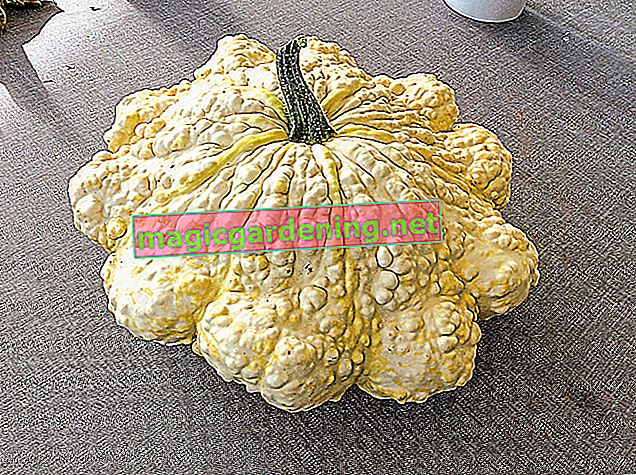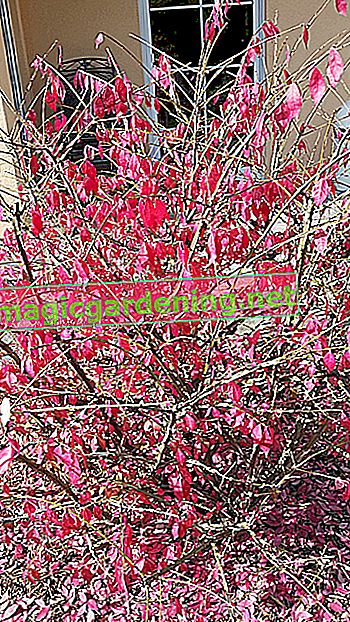
Not mandatory - but beneficial
For a long time, pruning roses in autumn was frowned upon. Reason for the taboo: The cut causes a fresh shoot that does not ripen before winter. A few minus degrees are sufficient for the soft shoot tips to freeze back into the wood and to destroy hopes for the next flowering period.
also read
- When is the best time to cut roses?
- If possible, plant roses in autumn
- When to plant roses
According to modern knowledge, slight frostbite on unwooded shoots is not a problem. On the contrary, uncut rose branches slow down bitterly cold wind, diverting it to the lower areas, so that local temperatures drop drastically and the buds freeze to death. If overly long rose shoots gesticulate in all directions, it is difficult to put on reliable winter protection. Last but not least, order-loving gardeners struggle with the unkempt appearance of uncut rose bushes for months.
Since practical experience underpins modern knowledge, there has been a rethink in the care of roses. Today rose gardeners decide - in addition to the spring and summer pruning - for another pruning time in autumn.
Cut bed and hybrid tea roses
As the summer progresses, bed, shrub and hybrid tea roses transform into a dense network of thorn-reinforced branches. When the flowering period is finally over in autumn and the leaves move in, withered flower heads and limp leaves spoil the rose bushes. There is no way of getting through to pile up the plant base as winter protection. There are several reasons for an autumn care cut. How to do it right:
- Sharpen, clean and disinfect rose shears with spirit
- Cut off dead flowers over the next pair of leaves or buds
- Cut back excessively long, disturbing shoots by a maximum of a third
- Pluck all dead leaves from the branches
When cutting your roses in autumn, you can easily approach the cut with shirt sleeves. Exceptionally, a perfect pruning technique on buds is not necessary. Precision is not required again until the main cut in spring.
Cut budding branches
If roses demonstrate their ability to bloom with buds in autumn, the shoots are far too good for the organic waste bin. Cut off budding or flowering branches at the roots. The royal blossoms unfold in the vase for some time. Although tightly closed buds do not open completely after an abrupt change from the cool garden to the warm room. The shoots always guarantee decorative accents with an autumnal flair.
Digression
Remove wild shoots continuously
Wild shoots strive to overgrow the noble rose until the last warm ray of sunshine. From early spring to the beginning of winter, the game underlay vehemently sends out vigorous shoots in order to gain the upper hand in the battle for light and nutrients. Keep an eye on your bed, shrub and hybrid tea roses throughout the season in order to remove wildlings promptly. The undesired shoots are easy to identify by the arrangement of their leaflets. With up to fifteen individual leaves, blind shoots differ significantly from cultivated roses, whose noble pinnate leaves are composed of an average of five individual leaves.Climbing roses - instructions for autumn pruning
Their exposed position on the trellis makes autumn pruning useful for climbing roses. If you don't want to be annoyed about withered flowers and brown foliage all winter long, you can pull out your rose shears again in autumn. Order-loving rose gardeners will not miss this opportunity to rearrange the tendrils. Here's how to do it properly:
- Detach inconveniently standing rose tendrils from the climbing frame and place on the ground
- Leave well-positioned shoots on the trellis
- Clean up dead flowers
- Shorten the shoots protruding over the support by a third
- Important: ideally do not cut this year's long shoots
- Completely remove dead leaves
After the autumn cleanup, tie the tendrils back on. If there is a lack of space on the climbing frame, start with this year's unbranched long shoots. Your climbing rose will have the most beautiful flowers on these tendrils next year. If a tendril has to give way, it should be an older, heavily branched specimen.
Cut and pack the standard roses
In autumn, a moderate maintenance cut paves the way for perfect winter protection on standard roses . This is where the sensitive refinement point is located below the crown and is therefore particularly susceptible to severe frost. Without a warming hood, a rose stem is at the mercy of winter hardships. The cover is easier to put on if you shorten the branches slightly beforehand. How to do it right:
- Rose crown approximately around one third cut back
- Pluck out accessible leaves
- Wrap the crown in a breathable winter fleece
- Tie the hood together on the trunk below the finishing point
In winter regions it is also advisable to put a bucket on wood and wrap it with bubble wrap or jute. Cover the substrate with autumn leaves (no rose petals), straw or bark mulch.
Tips
In no case should roses be fertilized in autumn. In the worst case, the nutrients induce a rose bush to sprout again. Soft shoots have nothing to oppose winter frost, freeze back and damage the entire plant. If you want to arm your roses with potassium for the cold season in autumn, apply the fertilizer no later than mid to late August.
Always dispose of clippings
Plant hygiene is a top priority when it comes to caring for roses. Hardly any modern hybrid tea rose is immune from disease. It is primarily the pretty pinnate leaves on which pathogenic agents settle. Varieties with the predicate 'ADR Rose' usually defend themselves against infection on their own. Cunning mushroom spores can still overwinter in the rose bed with the clippings or autumn leaves.
As a result, the pathogens will find their way to the leaves all the faster in the next year. In this way, an infestation that was barely noticeable in the previous year can take on serious proportions. Please dispose of clippings and fallen rose leaves in the garbage can. Pathogenic germs are not reliably killed on the compost heap.
Do not cut wild roses
Wild roses adorn the winter garden with colorful rose hips. For this reason alone, the natural beauties in autumn are no match for the secateurs. Environmentally conscious rose gardeners do without a cut, because the round fruits are a valuable source of food for hibernating birds.
background
Postpone planting until March
The plant cut plays a key role among the types of cut for roses. You can plant container roses all year round as long as it doesn't freeze. For bare-root roses, the time window for planting is open from October to March. If you decide on an autumn planting date, the planting is not done until the following spring . The forsythia flower gives a reliable indication of the best date. Cut all shoots back to 3 to 5 eyes. The cut causes the juice to jam, whereupon the young rose sprouts vigorously and branches out.Tips for the perfect cutting tool
The autumn rose cut focuses on withered flower heads and the upper third of the shoot. With a sharp pair of rose scissors, you are well equipped for a moderate, nourishing cut. Scissors with a bypass mechanism are recommended because two sharp blades run against each other and create smooth cuts. Especially under the influence of cool temperatures, it is important that cut surfaces close in good time before the first frost.
Thorn-proof gloves with long cuffs are indispensable. It is primarily the long gauntlets that protect your arms from painful injuries when you pluck dead leaflets from the interior of the bush.
frequently asked Questions
If I plant the 'Snow Queen' ground cover rose, do I have to prune it twice a year?
You can let ground cover roses grow freely. Annual pruning in March or April, especially during the first three to four years, is advantageous for bushy growth with abundant branches. Pruning twice a year would be too much of a good thing, as the creeping roses grow only slowly. In contrast to bed, shrub and hybrid tea roses, ground cover roses are not pruned in autumn.
My hybrid tea roses are still budding in September. What maintenance measures should I take? Can I just leave the shoots like that and cut them in spring?
You will prepare your roses perfectly for winter if you pile the plants generously. A protective cover is not required if you did your last fertilization in August. If you have fertilized in September, please protect the soft shoots that then sprout with an air-permeable fleece. If individual branches get in the way when attaching a hood, you can safely cut them off. Twigs with buds or last blossoms are ideal for a vase cut. You do the main pruning in spring, when the forsythia are in bloom.
When we move, we would like to take the most beautiful rose bushes with us. When and how should we ideally transplant the roses?
The best time to relocate your roses is during the leafless period in autumn or early spring. Please make sure that there were no rose plants at the new location before, otherwise soil fatigue is to be expected. Dig up the root ball generously so that the plants can take as much of the soil as possible with them. Cutting back in spring compensates for the lost root volume. An adequate water supply is important. Drought stress is the number one cause of roses dying after being transplanted.
Are there any special features to consider when cutting historical roses?
No, historical roses are treated in the same way as modern varieties in terms of pruning. In autumn, cut off withered flower heads and pile up the roses. When budding is imminent in spring, cut all shoots back to 5 eyes. Thanks to this pruning, it is guaranteed that the bushes branch well and grow healthily.
My hybrid tea rose bloomed wonderfully in the first summer and is 70 cm tall. In September a new, reddish-colored shoot formed, which has shot up a full 120 cm in height and does not bear any buds. Is it a game shoot?
You can recognize a game instinct by various characteristics. When it sprouts below the grafting point, a shoot comes from the wild stock. The grafting point can be identified as a thickening above the roots. If you cannot clearly identify the origin of the suspicious shoot, wait until it bears leaves. Wildlings reveal themselves with pinnate leaves made up of up to 15 individual leaves. In contrast to this, hybrid tea roses thrive with pinnate foliage made up of 3, 5 or 7 individual leaves. You tear off a wild shoot from the rhizome with a brave jerk. Cut a noble shoot back to a third in spring.
The 3 most common mistakes
If a rose gardener goes to work in a draconian manner with the autumn cut, massive frost damage is the result. If wild shoots can operate and operate unhindered in the rose bush until winter, they rob the precious part of important reserves for the next flowering period. Anyone who leaves autumn cuttings in the bed will increasingly have to fight rose diseases in the next year. The following table summarizes common mistakes related to autumn cut care with tips for prevention:
| Cutting errors | Damage | prevention |
|---|---|---|
| strongly cut in autumn | Frost damage to total failure | cut by a maximum of a third |
| Wild shoots not removed | poor shoots, few flowers | Tear wild shoots by winter |
| Autumn clippings left behind | Spread of disease | Always dispose of rose cuttings |
Tips
Capricious weather conditions and global warming make choosing a date for the main cut of roses a tightrope walk. A look at the calendar doesn't help. Mother Nature clearly signals when you should really cut your roses. As soon as forsythias herald the arrival of spring with bright yellow flowers, the ideal window of time for the rose cut opens.








